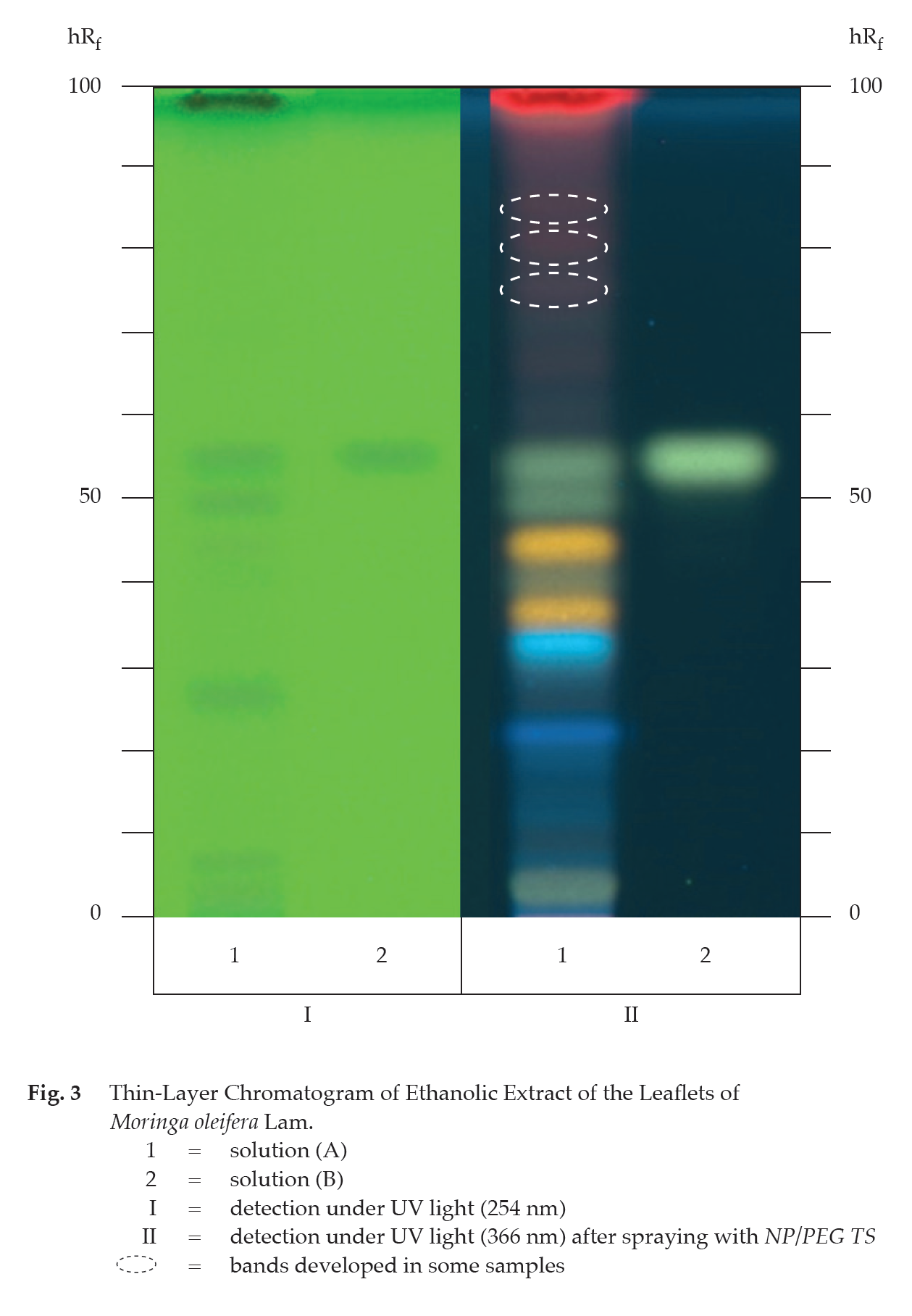ตำรามาตรฐานยาสมุนไพรไทย
Thai Herbal Pharmacopoeia
สำนักยาและวัตถุเสพติด กรมวิทยาศาสตร์การแพทย์ กระทรวงสาธารณสุข
Bureau of Drug and Narcotic, Department of Medical Sciences, Ministry of Public Health(Tinospora crispa (L.) Hook.f. & Thomson)
(Nelumbo nucifera Gaertn.)
(Centella asiatica (L.) Urb.)
(Centella Dry Extract)
(Centella Cream)
(Mesua ferrea L.)
(Piper sarmentosum Roxb.)
(Piper sarmentosum Roxb.)
(Pterocarpus santalinus L. f.)
(Santalum album L.)
(Senna tora (L.) Roxb.)
(Senna alata (L.) Roxb.)
(Senna Alata Tea)
(Piper retrofractum Vahl)
(Myristica fragrans Houtt)
(Andrographis paniculata (Burm. f.) Nees)
(Andrographis Capsules)
(Allium ascalonicum L.)
(Ocimum tenuiflorum L.)
(Curcuma longa L.)
(Turmeric Capsules)
(Turmeric Dry Extract)
(Turmeric Dry Extract Capsules)
(Arcangelisia flava (L.) Merr.)
(Curcuma sp.)
Harrisonia perforata (Blanco) Merr.
(Aristolochia pierrei Lecomte)
(Zingiber officinale Roscoe)
(Ginger Capsules)
(Ginger Tea)
(Cassia fistula L.)
(Nardostachys jatamansi (D. Don) DC.)
(Angelica sinensis (Oliv.) Diels)
Artemisia annua L.
(Ligusticum sinense Oliv. cv. Chuanxiong)
(Neopicrorhiza scrophulariiflora Pennell)
(Atractylodes lancea (Thunb.) DC.)
(Aucklandia lappa Decne)
(Terminalia chebula Retz.)
(Angelica dahurica (Hoffm.) Benth. & Hook. f. ex Franch. & Sav. var. dahurica)
(Kaempferia parviflora Wall. ex Baker)
(Hibiscus sabdariffa L.)
(Roselle Tea)
(Allium sativum L.)
(Zingiber zerumbet (L.) Sm.)
(Wurfbainia testacea (Ridl.) Škorničk.& A. D. Poulsen)
(Cannabis sativa L.)
(Myristica fragrans Houtt)
(Dracaena cochinchinensis (Lour.) S. C. Chen)
(Ficus racemosa L.)
(Hyptis suaveolens (L.) Poit.)
Clerodendrum indicum (L.) Kuntze
(Phyllanthus emblica L.)
(Citrus hystrix DC.)
(Citrus hystrix DC.)
(Areca catechu L.)
(Momordica charantia L.)
Moringa oleifera Lam.
(Aegle marmelos (L.) Corrêa)
(Solanum trilobatum L.)
(Morus alba L.)
Gynostemma pentaphyllum(Thunb.)
Makino
(Clinacanthus nutans (Burm. f.) Lindau)
(Cissus quadrangularis L.)
(Mimusops elengi L.)
(Zingiber montanum (J. König) Link. ex A. Dietr.)
(Piper betle L.)
(Capsicum annuum L.)
(Capsicum Oleoresin)
(Capsicum Gel)
(Piper nigrum L.)
(Piper nigrum L.)
(Eurycoma longifolia Jack)
(Thunbergia laurifolia Lindl.)
(Piper wallichii (Miq.) Hand.-Mazz.)
Senna garrettiana (Craib) H. S. Irwin & Barneby
(Terminalia bellirica (Gaertn.) Roxb.)
(Terminalia chebula Retz.)
(Caesalpinia bonduc (L.) H. Roxb.)
(Tarlmounia elliptica (DC.) H. Rob., S. C. Keeley, Skvaria & R. Chan)
(Hog Creeper Vine Dry Extract Capsiles)
(Hog Creeper Vine Dry Extract)
(Brachypterum scandens (Roxb.) Miq.)
(Lepidium sativum L.)
(Nigella sativa L.)
(Cuminum cyminum L.)
(Foeniculum vulgare Mill.)
(Plantago ovata Forssk.)
(Pimpinella anisum L.)
(Carum carvi L.)
(Anethum graveolens L.)
(Trachyspermum ammi (L.) Sprague)
Albizia procera (Roxb.) Benth.
(Acorus calamus L.)
(Tiliacora triandra (Colebr.) Diels)
Cyanthillium cinereum (L.) H. Rob.
(Orthosiphon aristatus (Blume) Miq.)
Murdannia loriformis (Hassk.) R. S. Rao & Kammathy
(Capparis micracantha DC.)
(Chrysopogon zizanioides (L.) Roberty)
(Cyperus rotundus L.)
(Cannabis sativa L.)
(Syzygium aromaticum (L.) Merr. & L. M. Perry)
(Boesenbergia rotunda (L.) Mansf.)
(Acanthus ebracteatus Vahl)
(Acanthus ilicifolius L.)
(Kaempferia galanga L.)
(Curcuma comosa Roxb.)
Betula alnoides Buch.-Ham. ex D. Don
Cannabis sativa L.
Carthamus tinctorius L
Mitragyna speciosa (Korth.) Havil
Mallotus repandus (Rottler) Müll. Arg
Azadirachta indica A. Juss. var. siamensis Valeton
Azadirachta indica A. Juss. var. siamensis Valeton
Punica granatum L.
Rhinacanthus nasutus (L.) Kurz
Baliospermum solanifolium (Burm.) Suresh
Curcuma aeruginosa Roxb
Boesenbergia kingii Mood & L. M. Prince
Senegalia rugata (Lam.) Britton & Rose
Acacia concinna (Willd.) DC.
Senegalia rugata (Lam.) Britton & Rose
Acacia concinna (Willd.) DC.
Senna alexandriana Mill. var. alexandriana
Cassia acutifolia Delile, Cassia angustifolia Vahl
Butea superba Roxb. ex Willd.
[Plaso superba (Roxb. ex Willd.) Kuntze, Rudolphia superba (Roxb. ex Willd.) Poir.
Pueraria candollei Graham
ex Benth. var. mirifica (Airy Shaw & Suvat.) Niyomdham
Streblus asper Lour.
Suregada multiflora (A. Juss.) Baill. (Gelonium
multiflorum A. Juss.
Drumstick-tree Leaf is the dried leaflets of Moringa oleifera Lam. (M. pterygosperma Gaertn.) (Family Moringaceae), Herbarium Specimen Number: DMSC 5262, Crude Drug Number: DMSc 0945.
Constituents Drumstick-tree Leaf contains flavonoids and their glycosides (e.g., astragalin, kaempferol, quercetin) and phenolic acids (e.g., gallic acid). It also contains nitrile, carbamate and isothiocarbamate glycosides, carbohydrates, proteins, minerals, etc.
Description of the plant (Fig. 1) Tree up to 12 m tall; bark smooth or finely rugose, pale grey or brownish, lenticellate. Leaves 2 to 4 imparipinnate, spirally arranged, 20 to 70 cm long; rachis articulate, with conspicuously small linear or clavate stalked glands at base of rachis and rachilla; petiole 7 to 15 cm long, pulvinate at base; leaflets ovate, obovate, or oblong, 0.5 to 3 cm long, 0.3 to 2 cm wide, apex round to subemarginate, whitish mucronulate, base round to cuneate, margin entire, membranaceous, puberulous when young, glabrous when mature; petiolule slender, 1 to 2 mm long, with stalked glands at base. Inflorescence paniculate, terminal and axillary, widely spreading, 10 to 30 cm long; bract and bracteole linear, about 1 mm long. Flower creamy white; hypanthium green; sepals 5, about 1.5 cm long, connate at base, proximal ones usually reflexed, puberulous, distal most pair usually largest, more or less erect, enclosing banner petal, or more or less reflexed; petals 5, lanceolate, 1 to 2 cm long, 5 to 8 mm wide, distal most banner petal more or less erect, others usually reflexed, puberulous, short stalk at base, apex acute; fertile stamens 5, staminodes 5, filament 0.7 to 1 cm long, basally pubescent, anther yellow, oblong, basifixed; ovary superior, 1-loculed, ovules numerous, style slender, 3 to 5 mm long, stigma minute. Fruit dehiscent, pendulous capsule, dagger-shaped, 18 to 70 cm long, 1 to 3 cm wide, acuminate, 3- or rarely 4-angled, subconstricted. Seed broadly elliptic or subglobose, 0.6 to 1 cm long, 0.5 to 1 cm wide, pale brown to dark brown; 3-winged, 2 to 4 cm long, 0.4 to 1 cm wide.
Description Odour, characteristic; taste, slightly bitter.
Macroscopic (Fig. 1) Drumstick-tree Leaf occurs as a mixture of entire and broken, green to brownish green leaflets, without petioles and rachis of the compound leaf. Complete leaflets, green to dark green on upper surface, greyish green or yellowish green on lower surface, ovate, obovate, or oblong, apex round to subemarginate, whitish mucronulate, base round to cuneate, margin entire, more or less glabrous.
Microscopical (Figs. 2a, 2b, 2c) Transverse sections of the leaflet through midrib and lamina show upper epidermis, mesophyll, vascular bundle, and lower epidermis. Upper epidermis: a layer of rectangular cells, sunken stomata, idioblasts, and unicellular trichomes.
Mesophyll: palisade cells, 1 to 3 layers, cylindrical, some containing oil droplet; spongy cells, irregularly shaped, loosely arranged, some containing oil droplets and rosette aggregates or prismatic crystals; collenchyma, angular, occurring in the lower part of midrib, some containing rosette aggregates. Vascular bundle: xylem in the upper part and phloem in the lower part. Lower epidermis: a layer of small rectangular cells, sunken stomata and unicellular trichomes.
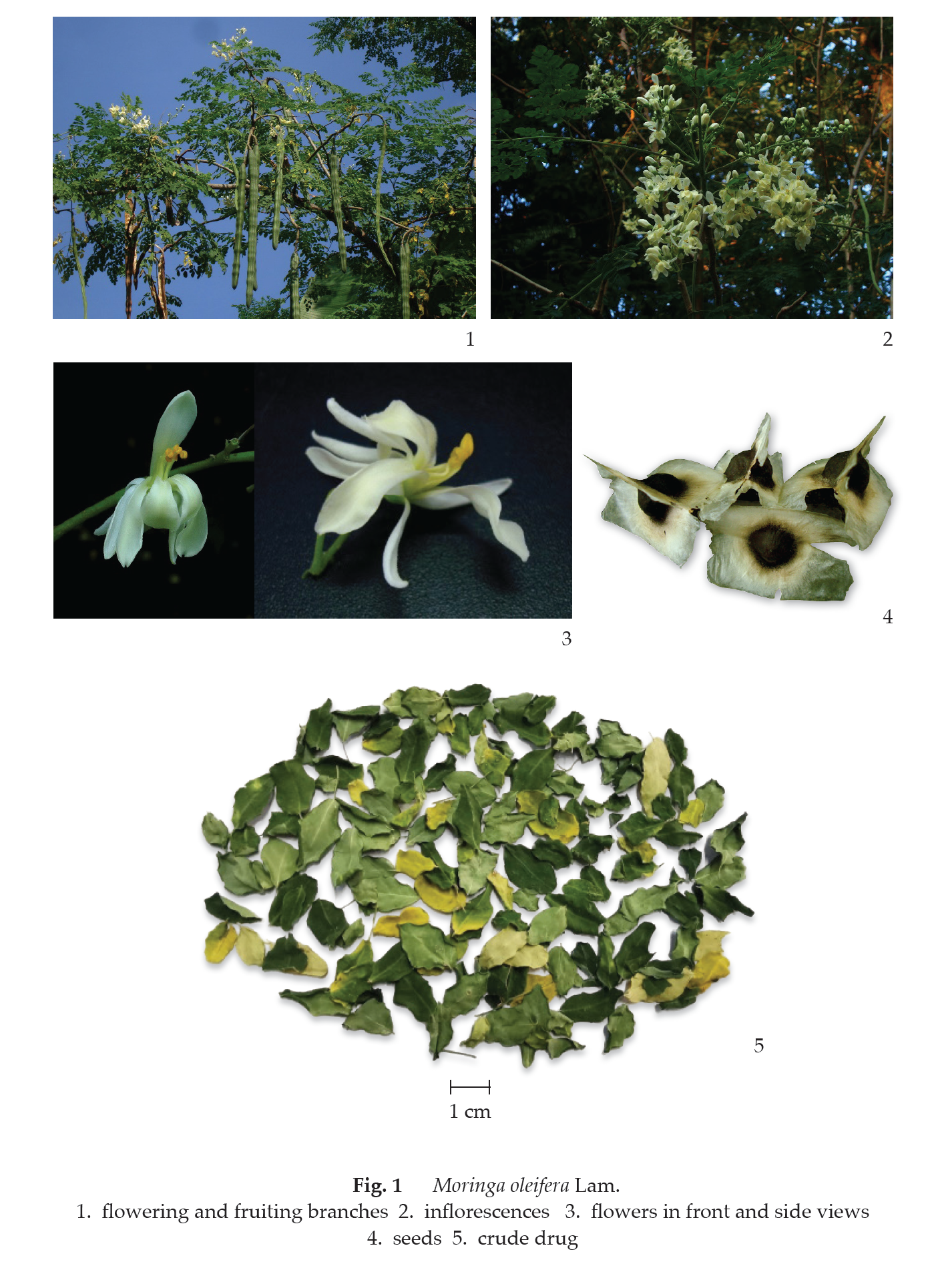
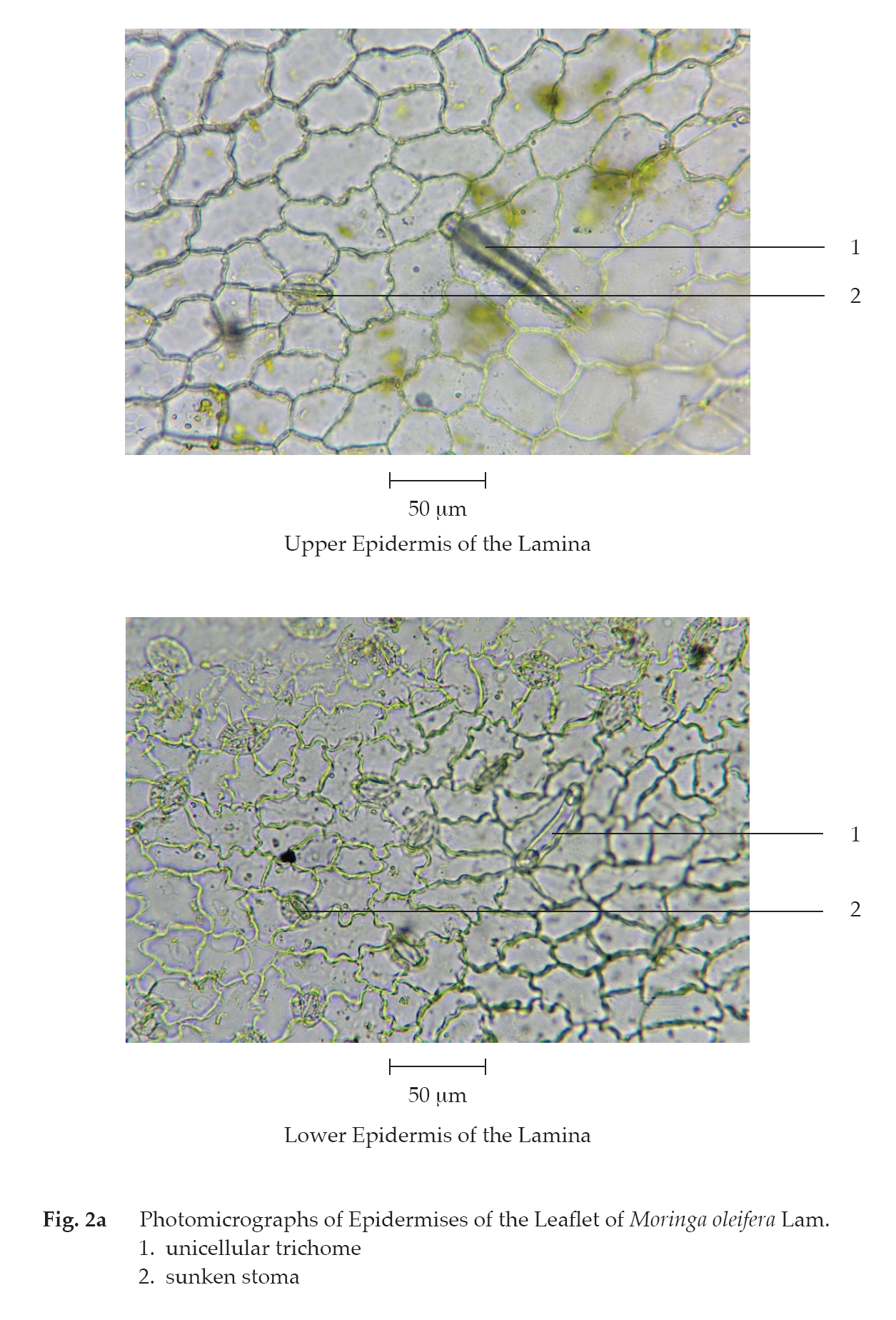
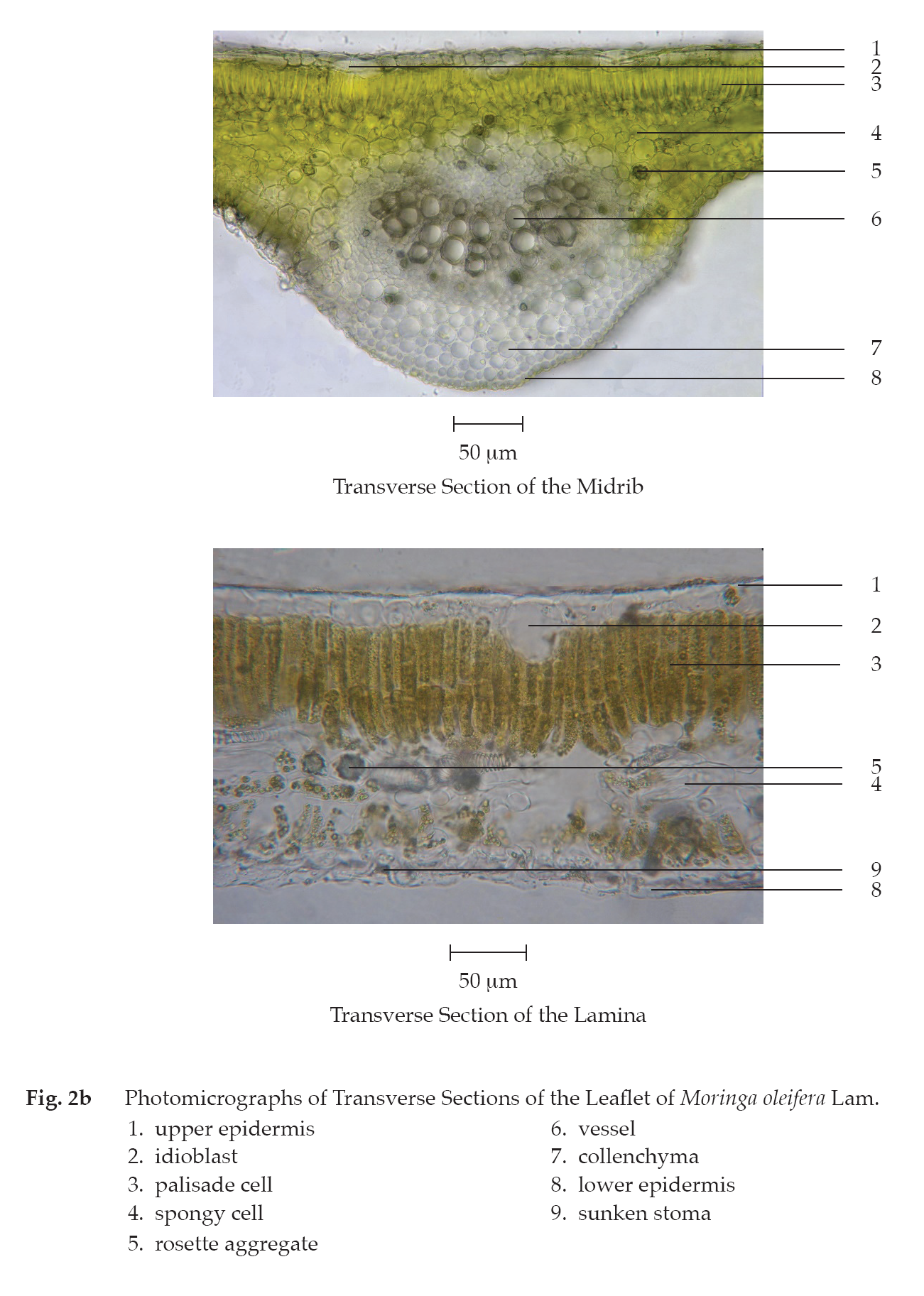
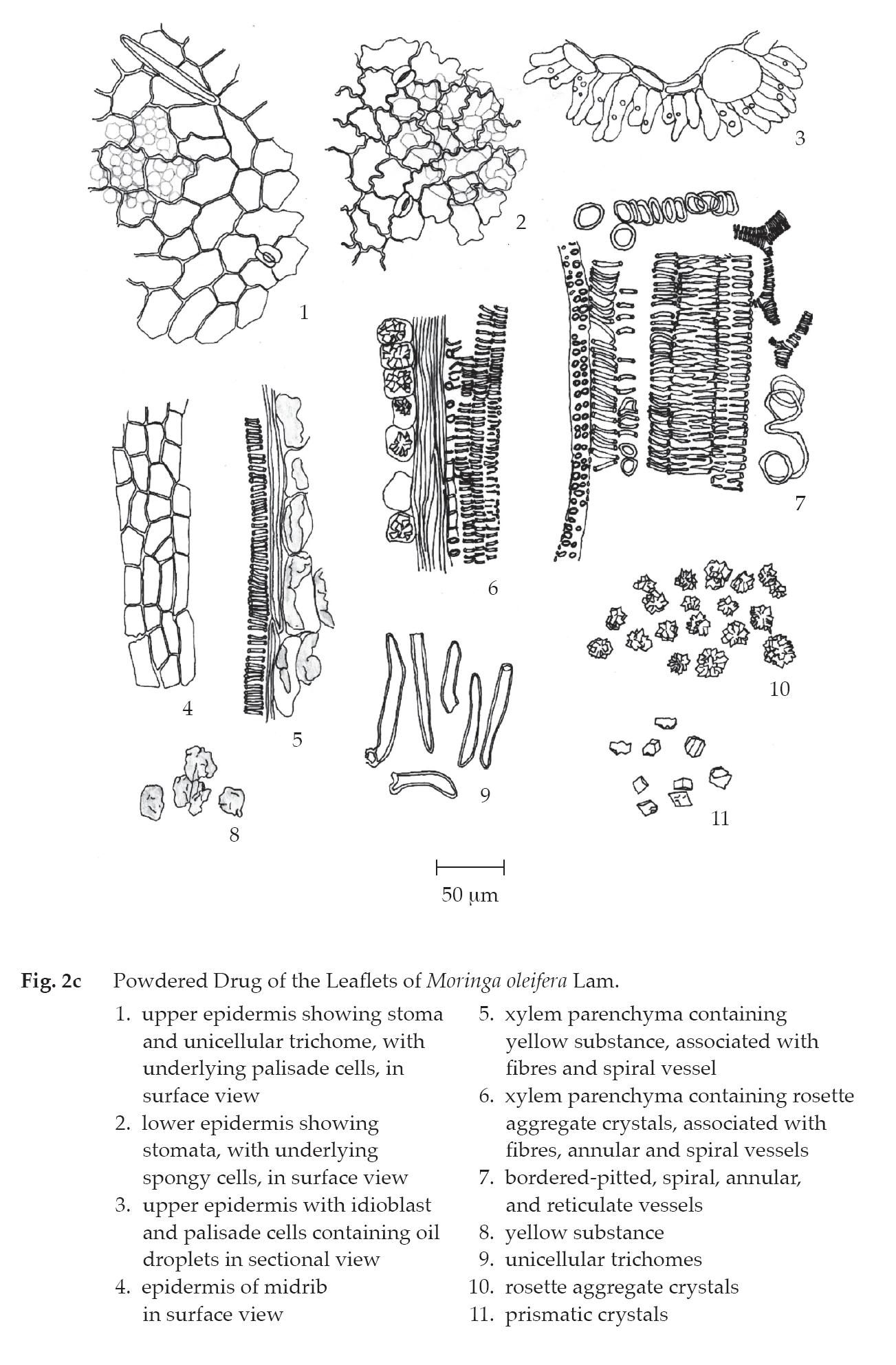
In surface view, upper and lower epidermises of the lamina show slightly wavy-walled cells, unicellular trichomes and sunken stomata.
Drumstick-tree Leaf in powder possesses the diagnostic microscopical characters of the unground drug. Sunken stomata in both upper and lower epidermises, palisade cells containing oil droplets and idioblasts are characteristic.
Packaging and storage Drumstick-tree Leaf shall be kept in well-closed containers, protected from light, and stored in a dry place.
Identification
A. Reflux 500 mg of the sample, in coarse powder, with 20 mL of water for 20 minutes and filter. To 1 mL of the filtrate, add a few drops of iron(III) chloride TS and mix: a black-blue colour develops.
B. Reflux 500 mg of the sample, in coarse powder, with 10 mL of absolute ethanol for 20 minutes and filter. To 1 mL of the filtrate, add 0.5 mL of a 0.2 per cent w/v solution of ninhydrin and warm on a water-bath for 2 minutes: a violet colour develops.
C. Carry out the test as described in the “Thin-Layer Chromatography” (Appendix 3.1), using a high-performance plate with silica gel F254 as the coating substance and a mixture of 80 volumes of ethyl acetate, 4 volumes of glacial acetic acid, 4 volumes of formic acid, and 8 volumes of water as the mobile phase and allowing the solvent front to ascend 8 cm above the line of application. Apply separately to the plate as bands of 10 mm, 4 μL of solution (A) and 2 μL of solution (B). Prepare solution (A) by refluxing 500 mg of the sample, in coarse powder, with 20 mL of absolute ethanol for 20 minutes, filtering and evaporating the filtrate under reduced pressure to dryness. Dissolve the residue in 4 mL of absolute ethanol. For solution (B), dissolve 1 mg of astragalin in 1 mL of absolute ethanol. After removal of the plate, allow it to dry in air and examine under ultraviolet light (254 nm), marking the quenching bands. The chromatogram obtained from solution (A) shows a quenching band (hRf value 55 to 57) corresponding to the astragalin band from solution (B) and several other quenching bands are also observed. Heat the plate at 80° for 10 minutes and then spray with natural products (NP) TS while the plate is still warm. Subsequently spray the plate with polyethyleneglycol (PEG) TS and observe the colours of the bands under ultraviolet light (366 nm) through the cut-off filter within 5 to 15 minutes; the band due to astragalin is green fluorescence and several other fluorescent bands of different colours are also observed (Table 1); see also Fig. 3.
Table 1 hRf Values of Components in Ethanolic Extract of the Leaflets of Moringa oleifera Lam.
| Band | hRf Value | Detection | |
| UV 254 | NP/PEG TS and UV 366 |
||
| 1 2 3 4 5 6 7 8 9 10 11* 12 13 14 |
2-3 7-9 13-14 22-23 29-30 33-34 36-37 39-40 45-46 50-51 55-57 74-75 80-81 83-85 |
- quenching - - quenching - - - weak quenching quenching quenching - - - |
blue - light blue blue - blue yellow light green yellow green green light red light red light red |
*astragalin
Loss on drying Not more than 10.0 per cent w/w after drying 5 g at 105° for 5 hours (Appendix 4.15).
Foreign matter Not more than 2.0 per cent w/w (Appendix 7.2).
Acid-insoluble ash Not more than 0.5 per cent w/w (Appendix 7.6).
Total ash Not more than 13.0 per cent w/w (Appendix 7.7).
Ethanol-soluble extractive Not less than 13.0 per cent w/w (Appendix 7.12).
Water-soluble extractive Not less than 30.0 per cent w/w (Appendix 7.12).
